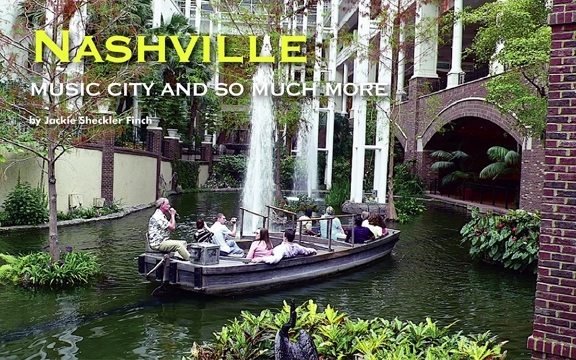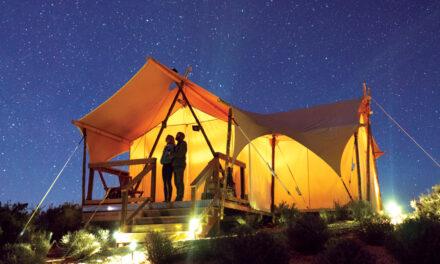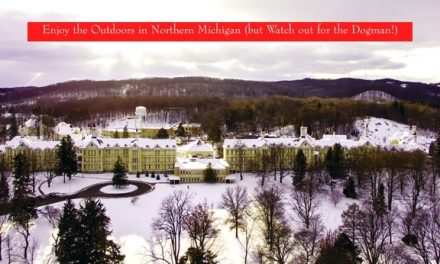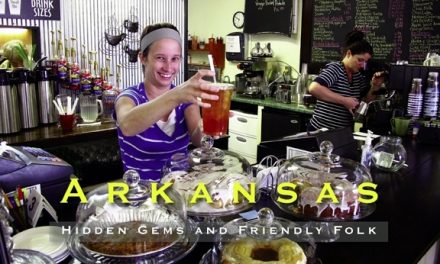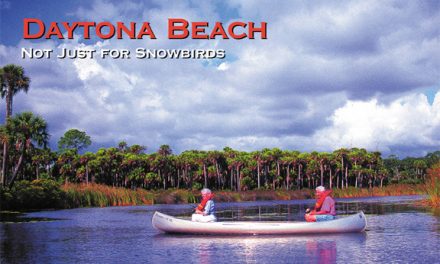Nashville
MUSIC CITY AND SO MUCH MORE
by Jackie Sheckler Finch 
I In the center stage of the Grand Ole Opry in Nashville, Tennessee, is a special piece of wood. It’s from the old Ryman Auditorium.
Overt the years, thousands of performers have stood on this circle – Hank Williams, Jim Reeves, Patsy Cline, Porter Wagoner, Dolly Parton, Loretta Lynn, Garth Brooks, Johnny Cash, June Carter Cash. Even a skinny truck driver from Memphis named Elvis Presley.
When the Grand Ole Opry moved to its present 4,400-seat home at Opryland USA in 1974, the circular section of the old Ryman stage was taken along as a reminder of the place the Opry had called home for more than three decades.
From its simple beginnings on Nov. 28, 1925, the Grand Ole Opry has never missed a Saturday night broadcast. Its audience, at first only a few hundred listeners with primitive radios and crystal sets, has grown to include millions around the world. The Opry is now the world’s longest running radio show.
As the daughter of an old-time fiddler player, I grew up listening to the Grand Ole Opry and its legendary performers. On a recent visit, I was curious to see if the show was what I had pictured in my mind as a little girl sitting around the radio with my father. I also wanted to see if Nashville lives up to its nickname of “Music City.”
GAYLORD OPRYLAND RESORT
The star of Nashville accommodations, the Gaylord Opryland Resort is a destination in itself. Even if you don’t stay at this awe-inspiring property, it’s worth stopping by to visit. Thousands of folks walk through every day and marvel at the three enormous themed atriums.
Opened in 1977, the resort has a whopping 2,881 rooms and 600,000 square feet of meeting and convention space. It also has more than 12 different restaurants and eateries, plus a nightclub, shops, spa, fitness center, three swimming pools and even a radio station.
You can get a workout just walking from one end to the other in the resort. The three indoor gardens are the Conservatory, the Cascades and the Delta. The Delta is so huge it even has it own river – big enough to carry passengers on flatboats on a guided tour of the landscaped Delta.
Opryland is a people watcher’s paradise. I enjoyed strolling through the Magnolia Lobby, sipping a cocktail in the Falls Bar and listening to the live band playing from one of the balconies before adjourning to my comfy room.
COUNTRY MUSIC HALL OF FAME AND MUSEUM
Early the next morning, I headed downtown to the Country Music Hall of Fame and Museum for an education in the roots of country music and its many singers and songwriters. Along with a wealth of permanent exhibits and artifacts, the museum also features changing exhibits. One of them that opened in March 2008 has proven so popular that it is being held over through 2011. Personally, I would like to see it become a permanent exhibit.
“Family Tradition: The Williams Family Legacy” traces the personal and professional lives of Hank Williams and Hank Williams Jr. and some of the most influential country music ever recorded. Among the memorabilia is the suitcase that Hank Sr. was carrying the night he died in the back seat of his baby blue Cadillac.
Somewhere in West Virginia, Williams’ young driver became worried about the lifeless body draped in a navy blue overcoat in the back seat. By then it was too late. Carried into an emergency room, Williams was pronounced dead Jan. 1, 1953. His heart had given out from drugs and alcohol. Williams was 29 years old.
“It’s an incredibly complex story,” said museum curator Carolyn Tate. “You could not make up this story with this family… We cried a lot and laughed a lot in creating this exhibit.”
STUDIO B
To see where some of that fantastic music was made, I caught a shuttle bus from the museum to Studio B. Located on historic Music Row, RCA’s Studio B is Nashville’s oldest recording studio and home to hits like Roy Orbison’s “Only the Lonely,” the Everly Brothers’ “Dream,” Dolly Parton’s “Jolene” and 250 hits by Elvis Presley including “Are You Lonesome Tonight.”
Known as the “Home of 1,000 Hits,” Studio B opened in 1957 and closed in 1977. A few years later, the studio was donated to the County Music Hall of Fame and Museum. Today, Studio B is a tourist attraction, as well as a working studio and learning laboratory for students at Belmont University. A video shows some of the greats who recorded at the studio.
All the studio equipment is original, including a well-worn piano once played by Elvis and Floyd Cramer. To get into the Christmas spirit for a holiday album that was being recorded in hot summer weather, Elvis had lights strung around the ceiling. They are still there today.
Take a look at the back of the simple brick bungalow when you leave. A subtle difference in the bricks is a reminder of Dolly Parton. The story goes that she was so excited to be recording at the famed studio and so thrilled to be driving a new car that she accidentally ran into the building.
No wonder when I returned to my Opryland room that night, I kept hearing Elvis singing in my ear. Then I awoke the next morning to the sound of Vince Gill. Instead of a standard wake-up call, the Opryland uses recorded voices of country singers to awaken guests with a cheery good morning call.
RYMAN AUDITORIUM
First up on my agenda this sunny Nashville morning was to visit the hallowed halls of the historic Ryman Auditorium, regarded as the “Mother Church of Country Music.” A National Historic Landmark, the Ryman was home of the Grand Ole Opry from 1943 to 1974. One of the city’s most popular concert venues, the Ryman is renowned for its exceptional acoustics and has hosted musicians from all genres.
The Ryman also has exhibits and information on the history of the building and country music, including memorabilia and photographs of such Opry stars as Kitty Wells, Hank Snow and Ernest Tubb. Life size bronze statues of Minnie Pearl and Roy Acuff greet visitors in the lobby.
For some great recordings and T-shirts, I wandered through the gift shop and left with a nice shopping bag filled with music to enjoy at home. Many Nashville gift shops also carry a southern delicacy known as the Goo Goo candy bar.
Said to be the first combination candy bar, the Goo Goo is a gooey recipe of fresh roasted peanuts, caramel, marshmallow and milk chocolate. Satisfying sweet tooths since 1912, the Goo Goo is still made right in Nashville at the Standard Candy Company,
SCHERMERHORN SYMPHONY CENTER
From country music to classical, I headed to Nashville’s new musical masterpiece – the Schermerhorn Symphony Center. Opened in 2006, the 1,844-seat center is home to the Nashville Symphony Orchestra as well as a venue for other music and events. Taking up a whole city block in downtown Nashville, the Schermerhorn design was inspired by some of the world’s great concert halls.
Besides the excellent acoustics, one design aspect I really enjoyed was the 30 soundproof windows above the hall. The windows make the Schermerhorn one of the only major concert halls in North America with natural light. It is such a pleasure to sit in one of the comfortable concert seats and hear the talented symphony with soft twilight spreading over the hall.
HONKY TONK ROW
After a leisurely dinner at the top-notch Capitol Grille at the historic Hermitage Hotel, I was ready for an evening at Nashville’s world famous honky tonks. First, a few words to savor that dining experience at the Capitol Grille. It is pure luxury – think truffles, foie gras, caviar and lobster. The emphasis is on creative Southern cuisine. Chef Tyler Brown uses the freshest and best available local products in what was once a private men’s club.
The sweet onion bisque with chives, bacon and a brie sandwich covered with the creamy soup was almost a meal in itself. The grilled Tennessee Black Angus beef tenderloin was served with roasted potatoes and carrots but I also got a taste of a friend’s truffled macaroni and cheese. Sure not like the mac and cheese I make from a box at home.
Nashville has a treasure of restaurants and I tried several on my visit – Fish & Co. with its tasty seafood menu, Savarino Cucina for homemade breads, pastas and pastries, Jack’s Bar-B-Que for authentic hickory-flavored barbecue, the hip Merchants with scrumptious beef short ribs, Cabana for unforgettable Tennessee sliders (mini sweet potato biscuits with Smoky Mountain country ham), and so many more delightful dining spots.
Fortified for a wonderful evening of music, I walked to some of the legendary downtown honky tonks, including Tootsie’s Orchid Lounge, Robert’s Western Wear and Legends Corner to see where country music legends got their start.
You can’t miss Tootsie’s. It’s the pale purple club where songwriters like Kris Kristofferson and Willie Nelson gathered to drink and write. Much of the lounge’s history is reflected in the photos on the walls. There isn’t a cover charge for Tootsie’s live entertainment day and night. Take a peek out the back door. An alley leads to the side door of the Ryman Auditorium. Many stars have been known to come out that Ryman door and into Tootsie’s for some southern comfort before and after they played the Ryman.
To answer my question, it is easy to see why Nashville is known as Music City. I’m sure my father would feel right at home if he could see the city today and hear the talents of long ago legends as well as the stars of tomorrow.
For more info on Nashville. Tennessee:
Visit Nashville Tourism at
www.visitmusiccity.com

